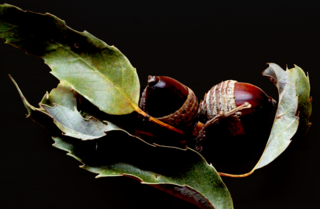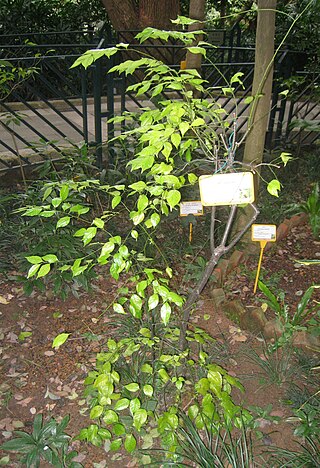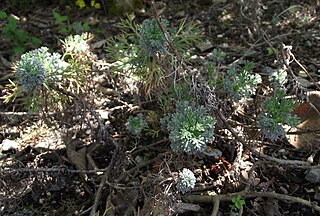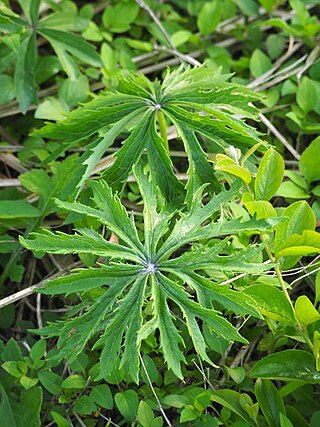
Rubus niveus is a species of Rubus. The native range of this scrambling shrub stretches from Afghanistan to central China, down to Java and Indo-China. It grows primarily in temperate regions.

Quercus stenophylloides, also called Arisan oak, is a species of evergreen, broad-leaf tree endemic to Taiwan. It is placed in Quercus subgenus Cerris, section Cyclobalanopsis.
Rubus pascuus is an uncommon North American species of brambles in the rose family. It grows only in the United States, primarily in the Ozarks of Missouri and Arkansas but with scattered populations farther east in New Jersey, Maryland, Virginia, and the Carolinas.

Acer caudatifolium is an Asian species of maple, found only in Taiwan. The species is sometimes confused with another Taiwanese tree, Acer morrisonense. This species has been known to reach 20 metres tall. Leaves are non-compound, the blade narrowly ovate, up to 11 cm long by 4.5 cm wide, with serrate margins but no lobes.

Rubus tricolor is an evergreen prostrate shrub, native to southwestern China. Leaves are dark green above, pale green below, and stems have red bristles. It has white flowers in summer and edible red fruit. It grows approximately 0.3 m (0.98 ft) high and usually forming a vigorously spreading, dense mat. In cultivation, it is mainly used as groundcover. Common names include Chinese bramble, groundcover bramble, creeping bramble, Korean raspberry, Himalayan bramble, and groundcover raspberry. In Chinese, it is called 三色莓.

Ilex asprella, also known as rough-leaved holly and plum-leaved holly, is a deciduous shrub native in South East Asia. Ilex asprella is one of the few deciduous species in the family Aquifoliaceae.

Cinnamomum kanehirae, also known as small-flowered camphor tree, or stout camphor tree, is a tree within the genus Cinnamomum of the family Lauraceae endemic to Taiwan.

Berberis morrisonensis, commonly known as Yushan barberry (Chinese:玉山小檗) or red fruit barberry (Chinese:红果小蘖、赤果小蘖) is a perennial deciduous shrub belonging to the genus Berberis and endemic to Taiwan.

Passiflora bogotensis is a climbing plant native to Colombia, in the genus Passiflora. It can also be found in Venezuela.
Salix alatavica is a small shrub from the genus of willow (Salix). It is native to mountainous slopes in Asia, in Kazakhstan, southern Russia, Mongolia, and northern China.
Zanthoxylum esquirolii is a woody plant in the family Rutaceae from Guizhou, Sichuan, and Yunnan China.
Zanthoxylum yuanjiangensis is a woody plant in the Rutaceae. It is native to Yuanjiang, Yunnan, China.
Crotalaria similis, also known as the Pingtung Curara pea, belongs to the family Fabaceae and genus Crotalaria. It is a perennial crawling herb, an endemic species of Taiwan which the distribution is limited to the Eastern seaside of the Hengchun Peninsula.
Lonicera kawakamii, also known as Yushan honeysuckle or Kawakami’s honeysuckle, is a species of flowering plant in the family Caprifoliaceae. It is endemic to Taiwan, where it is found at altitudes between 3000 and 3900 meters. It as rated as “Vulnerable” in the “Red List of Vascular Plants of Taiwan, 2017”.

Sabia swinhoei, known as Swinhoe's sabia, is a species that belongs to the Sabia genus in the Sabiaceae family. It was first published as a new species in Taiwan in 1886.

Artemisia kawakamii, commonly known as Kawakami's mugwort, is a plant in the Artemisia genus under the Asteraceae family that is endemic to Taiwan. The plant is distributed on the Taiwan island, growing at elevations from 2,700 to 3,300 m. It is commonly found in gravelly, open, and arid slopes. The species has yet to be cultivated.

Sedum sekiteiense is a Taiwan-endemic species of the family Crassulaceae in the Sedum genus. It is also one of the few wild plants named after Shiding. The species was first published by Yoshimatsu Yamamoto in 1934 in the Supplementa Iconum Plantarum Formosanarum. Although its taxonomic status has been stable, little is known about its ecological habits due to its rarity, limited distribution, and habitats that are often located on steep and inaccessible cliffs that are difficult to observe. The species is classified as “Vulnerable (VU)” in “The Red List of Vascular Plants of Taiwan, 2017.”

Syneilesis hayatae is one of two Taiwanese endemic plants in the genus Syneilesis, it is known as the Taiwan rabbit umbrella. Compared to the relatively stable population of Syneilesis subglabrata, this species was once thought to be extinct due to the lack of collection records for over half a century after World War II. In 2008 that the species was rediscovered in the lowland grasslands of Miaoli. Due to its small population size, the species was listed as “Critically Endangered (CR)” in the “Red List of Taiwan Vascular Plants, 2017.”

Prunus pogonostyla, the hairy-style cherry, is a species of flowering plant in the family Rosaceae, native to Manchuria, southeastern China, and Taiwan. A shrub or tree reaching 1.5 m (5 ft), with pink flowers, it is typically found growing on forested hillsides from 300 to 800 m.












